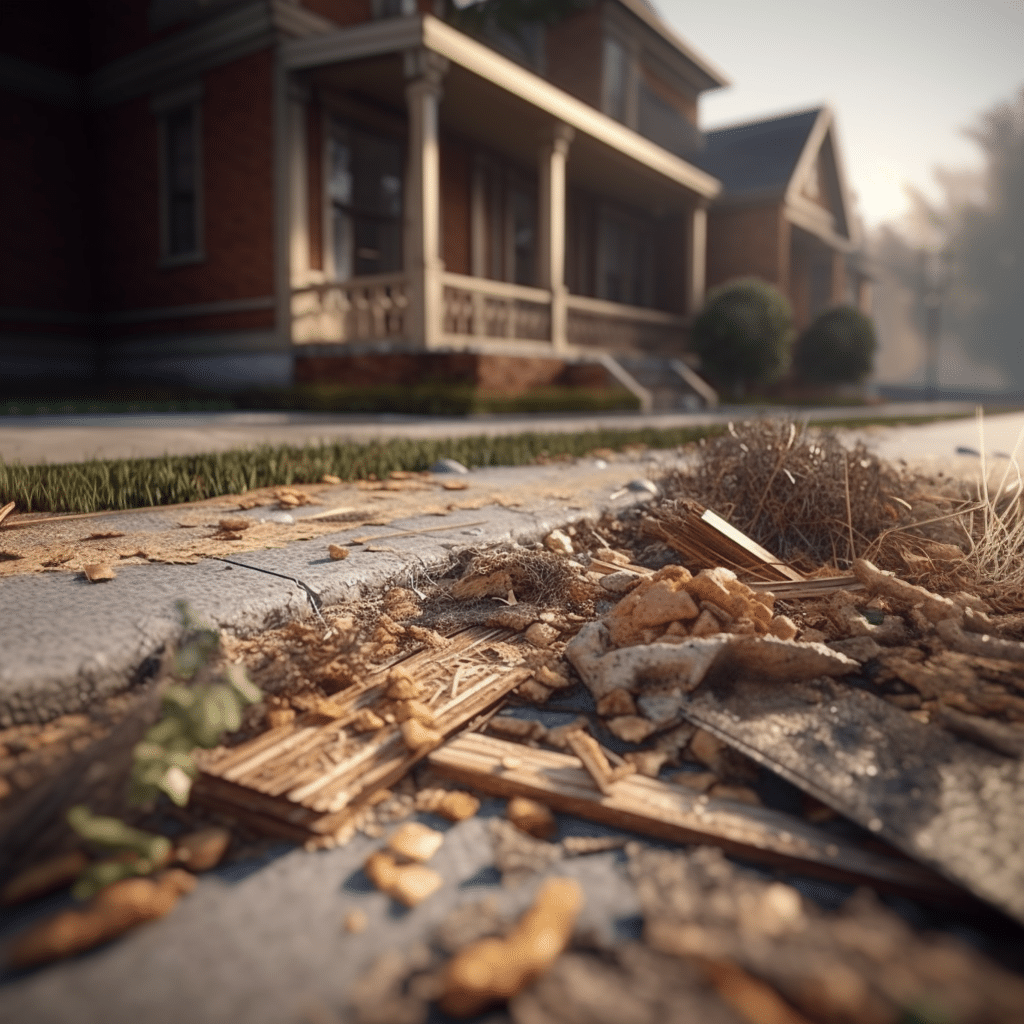Clearing the Rubble: What is Construction Debris Removal?
Defining Construction Debris Removal
Construction debris removal entails cleaning, transporting, and disposing of or recycling materials produced during construction activities. Whether you are building a skyscraper or renovating your kitchen, debris such as wood, concrete, metals, and plastics is inevitable. Managing this waste is not just about keeping the site clean; it is an integral component in ensuring the efficiency and safety of any construction project.
The Importance of Proper Disposal
It is critical to comprehend the significance of proper construction debris removal. Apart from the obvious aesthetic and organizational benefits, it profoundly affects the environment and sustainability. Properly managing construction waste minimizes pollution, reduces the consumption of raw materials, and lowers greenhouse gas emissions through reduced transportation needs. Furthermore, it is essential for compliance with various local and federal regulations, which, if not adhered to, could result in penalties.
The Composition of Construction Waste
Common Types of Construction Debris
Construction waste can encompass a wide range of materials. Some of the common types include:
- Concrete: Often found in large quantities and can be recycled for new construction projects.
- Wood and Timber: Used extensively in construction but often produces waste in the form of cut-offs and shavings.
- Metals: Such as steel and aluminum, are often used for their strength and are highly recyclable.
- Drywall: Commonly used for walls and can produce significant waste during construction.
- Plastics: Used for a variety of purposes, including insulation and piping.
- Hazardous Materials: Asbestos and lead-based paints require special handling and disposal procedures.
Environmental Impact of Construction Waste
The environmental impact of construction waste can be substantial. For example, improper disposal of materials like concrete and wood can contribute to landfill overflow and the consumption of valuable natural resources. Additionally, the transportation of these materials can lead to increased carbon emissions. If not correctly handled, hazardous materials can contaminate soil and water sources. The construction industry can mitigate these environmental impacts and contribute to a more sustainable future through conscious construction debris removal practices, including recycling and repurposing materials.
A Cleaner Site: Benefits of Construction Debris Removal
Enhancing Safety on the Construction Site
One of the immediate benefits of proper construction debris removal is the enhancement of safety on the construction site. Loose materials, especially around high-traffic areas, are hazardous to workers and machinery. Regularly clearing these materials can prevent accidents such as trips, falls, and equipment damage.
Streamlining the Construction Process
A clutter-free site is also an efficient site. Workers can move around quickly, machinery can be operated smoothly, and materials can be accessed without hindrance. This streamlining effect reduces the time spent looking for tools and navigating obstacles, ultimately reducing the overall construction timeline.
Contributions to Sustainability and Recycling
As previously mentioned, responsible construction debris removal positively impacts the environment. By recycling materials such as concrete, metals, and wood, construction sites can reduce the need for new raw materials. This conserves natural resources and supports the growing trend toward sustainable development in the construction industry.
Navigating Legalities: Regulations Surrounding Construction Waste Removal
Complying with Local and Federal Laws
Adhering to the legal requirements for construction debris removal is crucial. Different regions have varying regulations regarding the handling and disposal of construction waste. For example, some areas may have strict rules on recycling certain materials or special handling for hazardous substances. It is essential to be informed and compliant with these regulations to avoid legal repercussions and ensure environmentally responsible practices. Federal laws might also come into play, especially in cases involving large quantities of waste or handling hazardous materials.
Penalties and Consequences of Non-Compliance
Failing to comply with construction waste removal regulations can have severe consequences. Penalties can range from fines and sanctions to legal action and the revocation of licenses. Additionally, a company’s reputation can be tarnished, leading to a loss of business opportunities. Being proactive in understanding and following the rules is essential to responsible construction debris removal.
Tools of the Trade: Equipment Used in Construction Debris Removal
Heavy Machinery and its Role
Efficient construction debris removal often requires the use of heavy machinery. Excavators, bulldozers, and skid-steer loaders are commonly employed to gather and transport large waste materials. Additionally, specialized equipment like grapples and buckets can handle specific types of debris. These machines are vital in expediting debris removal, particularly in large construction projects.
Must have Safety Gear for Debris Handling
Handling construction debris involves several safety hazards, and the appropriate gear is critical. Standard safety equipment includes:
- Gloves: To protect hands from sharp objects and hazardous materials.
- Safety Glasses: To shield eyes from flying debris.
- Steel-toe Boots: To protect feet from heavy falling objects.
- Hard Hats: To safeguard the head in case of falling debris.
- High-Visibility Clothing: To ensure workers are easily seen on the construction site.
This safety gear minimizes the risk of injuries during the debris removal process and is necessary for anyone involved in handling construction waste.
Enlisting Expert Help: Why Hire Junk Removal Services?
When and Why You Need Professional Construction Waste Removal
There are scenarios where handling construction debris removal internally might not be the best option. This could be due to the scale of the project, the type of materials involved, or limitations in equipment and expertise. Professional junk removal services specialize in efficient and compliant construction waste removal. They possess the necessary equipment, knowledge of regulations, and expertise in handling various materials, including hazardous substances.
Evaluating Junk Removal Services: What to Look For
When looking to hire a junk removal service for construction debris removal, here are some factors to consider:
- Experience and Expertise: Assess their experience and knowledge in handling construction debris.
- Compliance with Regulations: Ensure they follow local and federal waste disposal regulations.
- Equipment: Verify that they have the necessary equipment to handle the scale of your project.
- Customer Reviews and Reputation: Check customer feedback and the company’s reputation in the industry.
- Pricing and Value: Compare pricing and ensure it aligns with the value they bring to your project.
The Cost Factor: Pricing and Value in Junk Removal Services
Understanding the cost implications is essential when hiring a junk removal service. Prices can vary based on factors such as the scale of the project, the types of materials involved, and the distance to the disposal site. It’s also important to understand what services are included
DIY Debris Management: Tips for Handling Construction Waste Yourself
Sorting and Separating Construction Debris
When managing construction debris removal independently, sorting and separating the materials efficiently is essential. Set up designated areas on the site for different types of waste, such as wood, metal, concrete, and hazardous materials. This sorting process will make transporting the materials for recycling or disposal easier and can also be required for compliance with specific regulations.
Safe Handling and Disposal Practices
Safety should be the top priority when handling construction waste. Always wear protective gear like gloves, safety glasses, and steel-toe boots. Be cautious when lifting heavy objects to avoid injuries, and ensure that pathways are clear to prevent tripping hazards. When disposing of materials, particularly hazardous ones, follow local regulations and guidelines to ensure you are not causing harm to the environment or putting yourself at risk of legal repercussions.
Recycling Opportunities for Construction Materials
Look for opportunities to recycle or repurpose construction materials. Many materials, such as wood, metal, and concrete, can be recycled. Not only is this environmentally responsible, but it can also be cost-effective. Some recycling centers even purchase certain types of construction waste. Materials like wood scraps can be repurposed for other projects or donated.





